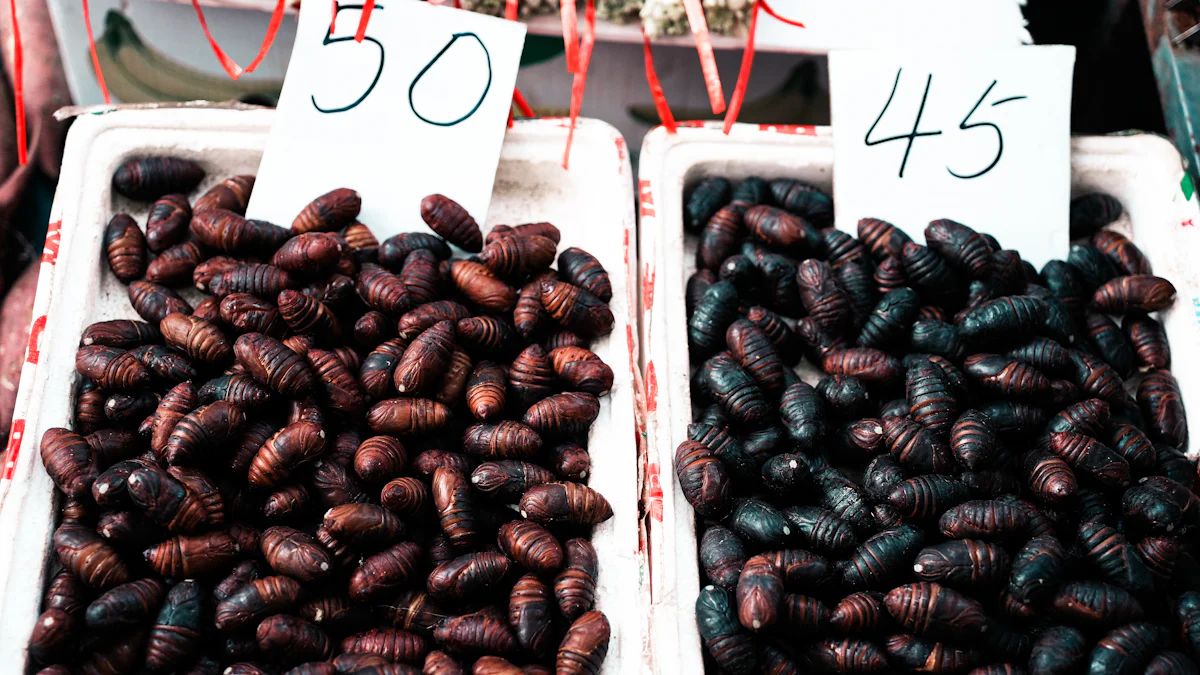
Storing bulk dried mealworms properly is essential to keep them fresh and nutritious. You want to make sure they last as long as possible, right? Well, the key lies in how you store them. By maintaining the right conditions, you can extend their shelf life significantly. Keep them in a cool, dry place, and avoid temperature fluctuations. This way, you’ll preserve their quality and nutritional value, ensuring they remain a reliable food source for your pets or poultry. Remember, good storage practices make all the difference!
Key Takeaways
- Store bulk dried mealworms in a cool, dry place with a stable temperature between 50°F and 70°F to maintain their nutritional quality.
- Keep humidity levels below 50% to prevent spoilage and mold growth, ensuring your mealworms remain safe for pets and poultry.
- Use plastic storage bins or airtight containers for short-term storage to protect against moisture and pests, while ensuring proper ventilation.
- For long-term storage, consider vacuum sealing or freezing mealworms to extend their shelf life and preserve their nutritional value.
- Regularly check your mealworms for signs of spoilage or pests, and implement a first-in, first-out system to minimize waste and maintain freshness.
- Repackage bulk mealworms into airtight containers after opening to protect them from air and moisture, and store them in a cool, dark place.
- Portioning mealworms into smaller packages can help control usage and ensure freshness, making it easier to feed different animals.
Ideal Storage Conditions for Bulk Dried Mealworms

When it comes to storing bulk dried mealworms, getting the conditions right is crucial. Let’s dive into the specifics of temperature and humidity to ensure your mealworms stay fresh and nutritious.
Temperature
Recommended temperature range for storage
You should store bulk dried mealworms at a stable temperature. Aim for a range between 50°F and 70°F. This range helps maintain their nutritional quality. Keeping them too warm or too cold can affect their shelf life and nutritional value.
Effects of temperature fluctuations on mealworm quality
Temperature fluctuations can be a real problem. If the temperature swings too much, it can lead to changes in the mealworms’ nutritional content. For instance, a study found that mealworms reared at higher temperatures had increased fat content but decreased protein levels. This means that if your storage area gets too warm, you might end up with mealworms that are less nutritious. So, keep an eye on that thermometer!
Humidity
Optimal humidity levels for storage
Humidity is another factor you need to control. Keep the humidity level low, ideally below 50%. This prevents moisture from getting into the mealworms, which can cause them to spoil. A dry environment is your best friend when it comes to storing these critters.
Consequences of improper humidity control
If you don’t manage humidity well, you might face some issues. High humidity can lead to mold growth and spoilage. This not only affects the mealworms’ quality but also makes them unsafe for your pets or poultry. So, make sure your storage area is dry and well-ventilated.
By maintaining the right temperature and humidity, you ensure that your bulk dried mealworms remain a valuable food source. Whether you’re feeding pets or raising poultry, these storage tips will help you get the most out of your mealworms.
Short-term Storage Strategies
When you’re storing bulk dried mealworms for short-term use, choosing the right containers and location is key. Let’s explore how you can keep your mealworms fresh and ready for use.
Suitable Containers
Types of containers for short-term storage
For short-term storage, you want to select containers that provide good ventilation. Plastic storage bins or containers with lids featuring small ventilation holes are excellent choices. These containers allow for proper airflow, preventing moisture buildup that can spoil your mealworms. Avoid using metal containers, as they can heat up quickly and harm the mealworms.
Benefits of airtight containers
Airtight containers offer several benefits for storing mealworms. They help maintain a stable environment by keeping out excess moisture and pests. This ensures your mealworms stay fresh and nutritious. While ventilation is crucial, an airtight seal can protect against sudden humidity changes, making it a reliable option for short-term storage.
Location Considerations
Best places to store mealworms for short-term use
Finding the right spot to store your mealworms is just as important as choosing the right container. A cool, dark place like a pantry or cabinet works well. Ensure the area is free from temperature fluctuations. Mealworms stored in such conditions can last up to six months without losing quality.
Avoiding exposure to direct sunlight and heat sources
Direct sunlight and heat sources can degrade the quality of your mealworms. Keep them away from windows or appliances that emit heat. High temperatures can cause mealworms to spoil faster, reducing their nutritional value. By storing them in a shaded, cool area, you ensure they remain a reliable food source for your pets or poultry.
By following these short-term storage strategies, you can keep your bulk dried mealworms fresh and ready for use. Whether you’re feeding pets or raising poultry, these tips will help you maintain the quality and nutritional value of your mealworms.
Long-term Storage Solutions
When you’re thinking about storing bulk dried mealworms for the long haul, you need to consider some effective strategies. Let’s explore vacuum sealing and freezing as two excellent methods to keep your mealworms fresh and nutritious over time.
Vacuum Sealing
Advantages of vacuum sealing for long-term storage
Vacuum sealing offers a fantastic way to store bulk dried mealworms for extended periods. By removing air from the packaging, you significantly reduce the risk of moisture and pests getting in. This method helps maintain the mealworms’ nutritional value and keeps them fresh for a longer time. You can rest easy knowing that your mealworms are safe from spoilage and contamination.
How to properly vacuum seal mealworms
To vacuum seal your mealworms properly, start by placing them in a vacuum-sealable bag. Make sure the mealworms are evenly distributed in the bag. Use a vacuum sealer to remove the air and seal the bag tightly. Store the sealed bags in a cool, dry place. This process ensures that your mealworms remain in top condition, ready to provide essential nutrients to your pets or poultry whenever needed.
Freezing
Steps for freezing mealworms
Freezing is another excellent option for long-term storage. Begin by spreading the mealworms on a baking sheet in a single layer. Place the sheet in the freezer for a few hours until the mealworms are frozen solid. Once frozen, transfer them to airtight freezer bags or containers. Label the bags with the date to keep track of their storage time. This method helps preserve the mealworms’ quality and extends their shelf life.
Thawing process and maintaining quality
When you’re ready to use the frozen mealworms, take them out of the freezer and let them thaw at room temperature. Avoid using heat to speed up the thawing process, as it can affect the mealworms’ texture and nutritional content. Once thawed, use them promptly to ensure they remain a nutritious food source for your pets or poultry. By following these steps, you can maintain the quality of your mealworms and make the most of your bulk purchase.
By implementing these long-term storage solutions, you ensure that your bulk dried mealworms stay fresh and nutritious. Whether you’re feeding pets or raising poultry, these methods will help you maximize the value of your mealworms over time.
Packaging Options for Bulk Dried Mealworms

When it comes to storing Bulk Dried Mealworms, choosing the right packaging can make a big difference in maintaining their freshness and quality. Let’s explore the options you have for bulk and individual portion packaging.
Bulk Packaging
Pros and cons of bulk packaging
Bulk packaging is a popular choice for many because it offers convenience and cost-effectiveness. You can purchase large quantities of mealworms at a lower price per unit, which is great if you have many pets or poultry to feed. Bulk packaging also reduces the need for frequent purchases, saving you time and effort.
However, there are some downsides to consider. Once you open a bulk package, the mealworms are exposed to air and moisture, which can lead to spoilage if not stored properly. You need to ensure that the packaging is resealable or transfer the mealworms to an airtight container to maintain their quality.
Tips for repackaging after opening
After opening a bulk package, it’s crucial to repackage the mealworms to keep them fresh. Here are some tips:
- Use airtight containers: Transfer the mealworms into plastic or glass containers with tight-fitting lids. This prevents moisture and pests from getting in.
- Add ventilation: If you’re using a container with a lid, make sure it has small holes for airflow. This helps prevent moisture buildup.
- Store in a cool, dark place: Keep the repackaged mealworms in a pantry or cabinet away from direct sunlight and heat sources. This helps maintain their nutritional value.
Individual Portion Packaging
Benefits of portioning mealworms
Portioning mealworms into smaller packages can be beneficial, especially if you have different feeding schedules or multiple animals. It allows you to control the amount you use each time, reducing waste and ensuring that each portion remains fresh until needed. This method is particularly useful if you’re feeding a variety of animals, such as chickens, reptiles, or fish, each requiring different amounts.
Methods for creating individual portions
Creating individual portions is simple and effective. Here’s how you can do it:
- Use small bags or containers: Divide the mealworms into smaller quantities and place them in zip-lock bags or small containers. Label each with the date to keep track of freshness.
- Vacuum seal for longer storage: If you want to store portions for an extended period, consider vacuum sealing. This removes air and helps preserve the mealworms’ quality.
- Freeze portions if necessary: For even longer storage, you can freeze the individual portions. Just make sure to thaw them properly before use to maintain their nutritional content.
By selecting the right packaging option, you can ensure that your bulk dried mealworms remain a nutritious and reliable food source for your pets or poultry. Whether you choose bulk or individual portion packaging, these strategies will help you maximize the value and effectiveness of your mealworms.
Tips for Maintaining Freshness
Keeping your bulk dried mealworms fresh requires a bit of attention, but the rewards are well worth the effort. By following these tips, you can ensure that your mealworms remain a nutritious and reliable food source for your pets or poultry.
Regular Checks
Importance of checking for spoilage or pests
Regularly checking your mealworms is crucial. You want to make sure they stay fresh and free from pests. Spoiled mealworms can lose their nutritional value and may even harm your pets. By inspecting them often, you can catch any issues early and take action to prevent further spoilage.
Signs of deterioration to watch for
Look out for signs of deterioration. If you notice any unusual odors, discoloration, or mold, it’s time to take action. These are clear indicators that your mealworms are no longer fresh. Also, keep an eye out for pests like beetles or mites. If you spot any, remove the affected mealworms immediately to prevent the problem from spreading.
Rotation Practices
Implementing a first-in, first-out system
A first-in, first-out (FIFO) system is a great way to keep your mealworms fresh. By using the oldest mealworms first, you ensure that none go to waste. This system helps you maintain a consistent supply of fresh mealworms, which is especially important if you’re feeding multiple pets or poultry.
Benefits of regular rotation for freshness
Regular rotation offers several benefits. It minimizes waste by ensuring that all mealworms are used before they spoil. This practice also helps you keep track of your inventory, so you know when it’s time to restock. By rotating your mealworms regularly, you can provide your pets with the highest quality nutrition.
"By maintaining the right temperature, humidity, and environment, you can keep your mealworms fresh and viable for extended periods."
Whether you’re using mealworms for pet food, poultry feed, or even as a fascinating hobby, these tips will help you maintain their freshness and quality. Happy mealworm keeping!
Storing Bulk Dried Mealworms effectively ensures they remain a nutritious and reliable food source. By choosing airtight containers and maintaining a cool, dry environment, you prevent spoilage and extend their shelf life. Regular checks and proper rotation practices keep your mealworms fresh and viable. Whether you’re feeding pets or raising poultry, these storage tips help you maximize the value of your mealworms. Implement these strategies to maintain quality over time and enjoy the benefits of well-preserved mealworms in your animal care routine.
FAQ
How should you store mealworms for short-term and long-term use?
For short-term storage, keep your mealworms at room temperature. Ensure they have proper ventilation and a food source like vegetables or fruits. For long-term storage, place them in the refrigerator. Maintain temperatures between 40°F and 50°F to keep them fresh.
How can you keep mealworms fresh for optimal storage and use?
To keep mealworms fresh, focus on stock rotation, moisture control, and bedding replacement. Maintain the right temperature and environment. These steps ensure your mealworms stay viable and nutritious.
What are the best practices for storing mealworms?
Follow these best practices: rotate your stock regularly, control moisture levels, and replace bedding as needed. Address common issues like pupation, mold, and dehydration promptly. These practices help maintain the quality of your mealworms.
What are the recommended storage methods for harvested mealworms?
Store harvested mealworms in the refrigerator or freezer. This helps maintain their quality and prolongs their shelf life. Refrigeration keeps them fresh, while freezing offers long-term preservation.
What is the recommended storage method for dried mealworms?
Freeze dried mealworms or store them in the refrigerator. Use a clean, tight-sealing freezer bag. This method keeps them fresh for up to a year, ensuring they remain a reliable food source.
Can you use dried mealworms for different purposes?
Absolutely! Dried mealworms serve various purposes. They’re a nutritious treat for pets like birds and reptiles. Poultry farmers use them to supplement chicken diets. Their high protein content makes them valuable in different feeding scenarios.
Why is moisture control important when storing mealworms?
Moisture control prevents spoilage and mold growth. Mealworms exposed to high humidity can deteriorate quickly. Keeping them dry ensures they remain fresh and safe for consumption.
How do you know if mealworms have gone bad?
Check for unusual odors, discoloration, or mold. These signs indicate spoilage. Also, watch for pests like beetles or mites. If you notice any of these, remove the affected mealworms immediately.
What are the benefits of using mealworms in poultry farming?
Mealworms provide high-quality protein for poultry. They enhance growth and improve egg production. Farmers appreciate their nutritional value and ease of use. Mealworms contribute to healthier and more productive flocks.
How do you implement a first-in, first-out system for mealworms?
Use the oldest mealworms first. This system minimizes waste and ensures freshness. Label containers with dates to track usage. Regular rotation keeps your mealworms in top condition.


